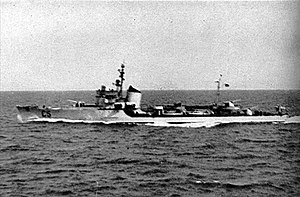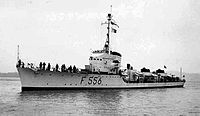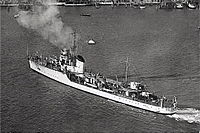Spica-class torpedo boat
Spica-class torpedo boat
Jump to navigation
Jump to search
 Torpedo boat Cassiopea | |
| Class overview | |
|---|---|
| Operators: |
|
| Preceded by: | Curtatone class |
| Succeeded by: | Ariete class |
| Built: | 1934–37 |
| In service: | 1935–64 |
| Completed: | 32 |
| Lost: | 23 |
| General characteristics | |
| Type: | Torpedo boat |
| Displacement: |
|
| Length: | 83.5 m (273 ft 11 in) |
| Beam: | 8.1 m (26 ft 7 in) |
| Draught: | 2.55 m (8 ft 4 in) |
| Installed power: | 19,000 hp (14,200 kW) |
| Propulsion: | 2 boilers, 2 steam turbines, 2 shafts |
| Speed: | 34 knots (39 mph; 63 km/h) |
| Complement: | 116 |
| Sensors and processing systems: | Sonar and hydrophones |
| Armament: |
|
The Spica class were a class of torpedo boats of the Regia Marina (Royal Italian Navy) during World War II. These ships were built as a result of a clause in the Washington Naval Treaty, which stated that ships with a tonnage of less than 600 could be built in unlimited numbers. Thirty-two ships were built between 1934 and 1937, thirty of which entered service with Italy and two which were transferred to the Swedish Navy in 1940. The two units in Swedish service were classed as destroyers until 1953, then re-classified as corvettes. Although commonly referred to as torpedo boats due to their smaller displacement, the Spica class armaments were similar in design to destroyers (their design was influenced by the Maestrale-class destroyer then in development), and were intended for anti-submarine duties, although they often had to fight aircraft and surface forces as well. Twenty-three vessels were lost during World War II.
Contents
1 Design
2 Ships
3 See also
4 References
4.1 Notes
4.2 Bibliography
5 External links
Design[edit]
The design work started in 1932 and two prototypes, Spica and Astore, were built. The hull was 80 metres (260 ft) long and displacement was around 720 short tons (650 t) standard rather than the 600 short tons (540 t) permitted by the Washington treaty. Propulsion consisted of a two shaft geared turbine layout with two Yarrow–type boilers. The armament consisted of three 100 mm (4 in)/47 caliber dual-purpose guns in single mountings in 'A', 'X' and 'Y' positions and three or four twin 13.2 mm (0.52 in) anti-aircraft machine guns—later replaced by 9 to 11 Breda 20/65 modello 35 20 mm cannons in various configurations. They also carried four 450 mm (18 in) torpedo tubes, two for each side, which had a shorter range and a smaller warhead than the 533 mm (21 in) ones in use on destroyers.
.mw-parser-output .mod-gallerydisplay:table.mw-parser-output .mod-gallery-defaultbackground:transparent;margin-top:0.5em.mw-parser-output .mod-gallery-centermargin-left:auto;margin-right:auto.mw-parser-output .mod-gallery-leftfloat:left.mw-parser-output .mod-gallery-rightfloat:right.mw-parser-output .mod-gallery-nonefloat:none.mw-parser-output .mod-gallery-collapsiblewidth:100%.mw-parser-output .mod-gallery .titledisplay:table-row.mw-parser-output .mod-gallery .title>divdisplay:table-cell;text-align:center;font-weight:bold.mw-parser-output .mod-gallery .maindisplay:table-row.mw-parser-output .mod-gallery .main>divdisplay:table-cell.mw-parser-output .mod-gallery .captiondisplay:table-row;vertical-align:top.mw-parser-output .mod-gallery .caption>divdisplay:table-cell;display:block;font-size:94%;padding:0.mw-parser-output .mod-gallery .footerdisplay:table-row.mw-parser-output .mod-gallery .footer>divdisplay:table-cell;text-align:right;font-size:80%;line-height:1em.mw-parser-output .mod-gallery .gallerybox .thumb imgbackground:none.mw-parser-output .mod-gallery .bordered-images imgborder:solid #eee 1px.mw-parser-output .mod-gallery .whitebg imgbackground:#fff!important.mw-parser-output .mod-gallery .gallerybox divbackground:#fff!important

Aretusa (F 556) in service with the Marina Militare in the 1950s

Torpedo boat Cigno
Ships[edit]
| Ship | Hull ltr.s[1] | Builder | Completed | Operational history |
|---|---|---|---|---|
Airone | AO | Ansaldo, Sestri Ponente | 10 May 1938 | Sunk 12 October 1940 in the battle of Cape Passero by British cruiser HMS Ajax. She scored three hits from her main guns on the British cruiser before being disabled. Ajax herself was hit by seven shells that destroyed one of her whalers, caused severe damage to the bridge and radar installation and 35 casualties, including 13 killed.[2] |
Alcione | AC | Ansaldo, Sestri Ponente | 10 May 1938 | Sunk 11 December 1941 by submarine HMS Truant. |
Aldebaran | AL | Ansaldo, Sestri Ponente | 6 December 1936 | Sunk 20 October 1941 in the Saronic Gulf, by mines laid by submarine HMS Rorqual. |
Altair | AT | Ansaldo, Sestri Ponente | 23 December 1936 | Sunk 20 October 1941 in the Saronic Gulf, by mines laid by submarine HMS Rorqual. |
Andromeda | AD | Ansaldo, Sestri Ponente | 6 December 1936 | Sunk 17 March 1941 at Valona, Albania, torpedoed by British bombers. |
Antares | AN | Ansaldo, Sestri Ponente | 23 December 1936 | Sank Greek submarine Proteus 29 December 1940. Sunk 28 March 1943 at Livorno by USAAF bombers. |
Aretusa | AU | Ansaldo, Sestri Ponente | 1 July 1938 | Survived the war and served in the post war Marina Militare. Decommissioned 1 August 1958. |
Ariel | AE | Ansaldo, Sestri Ponente | 1 July 1938 | Sunk 12 October 1940 in the battle of Cape Passero by British cruiser HMS Ajax. |
Astore | AS | BSN, NaplesA | 30 May 1935 | Sold to Sweden as Remus in 1940. Decommissioned 1958. |
Calipso | CI | Ansaldo, Sestri Ponente | 16 November 1938 | Sunk 5 December 1940, by mines east of Tripoli. |
Calliope | CP | Ansaldo, Sestri Ponente | 28 October 1938 | Up until September 1943, she provided 117 escort missions to merchant ship convoys and took part in 21 various combat missions covering a total of more than 77,500 miles. Shot down six British aircraft in different actions while escorting convoys to Libya.[3] Survived the war and served in the post war Marina Militare. Decommissioned 1 August 1958. |
Canopo | CA | CT, Riva TrigosoB | 31 March 1937 | Sunk 3 May 1941 by British bombers at Tripoli. |
Cassiopea | CS | CT, Riva TrigosoB | 26 April 1937 | Sank British destroyer HMS Pakenham in battle southeast of Marettimo island, on 16 April 1943, while escorting a transport ship to Tunis. Heavily damaged, she managed to limp away, taken in tow by Climene.[4] Survived the war and served in the post war Marina Militare. Decommissioned 1959. |
Castore | CT | CNR, AnconaC | 16 January 1937 | Fought off several British motor boats and small vessels attempting to land at Tobruk as part of Operation Agreement. She later rounded up a number of British survivors and small amphibious craft from the sea. Sunk 2 June 1943 by Allied destroyers HMS Jervis and Vasilissa Olga while escorting a convoy of two small freighters from Taranto to Messina, which reached destination safely.[5] |
Centauro | CO | CNR, AnconaC | 16 June 1936 | Sunk 4 November 1942, bombed in Benghazi harbour. |
Cigno | CG | CNR, AnconaC | 15 March 1937 | She was part of the screen of destroyers and torpedo boats escorting a four-freighter convoy to Tripoli on 26 May 1941,[6] when two Blenheim bombers were shot down.[7]Cigno rescued hundreds of Italian survivors after the Battle of Cape Bon, where she dodged four torpedoes launched by the Dutch destroyer HNLMS Isaac Sweers. Sunk in battle 16 April 1943 southeast of Marettimo island, by British destroyers HMS Paladin and HMS Pakenham, while escorting a transport ship to Tunis. Pakenham was also sunk in the same engagement.[4] |
Circe | CC | Ansaldo, Sestri Ponente | 4 October 1938 | Attempted to ambush a British convoy along with Vega south of Pantelleria in January 1941. Vega was sunk and the British cruiser HMS Bonaventure was damaged in the exchange of fire.[8] Sank submarines HMS Grampus, HMS Union, HMS P38 and HMS Tempest. Sunk by collision 27 November 1942. |
Climene | CE | CNR, AnconaC | 24 April 1936 | She took part in the shooting down of three Beaufort bombers and a Beaufighter while escorting a convoy between 20–21 August 1942.[9] Sunk 28 April 1943 by submarine HMS Unshaken. |
Clio | CL | Ansaldo, Sestri Ponente | 2 October 1938 | Sank submarine HMS Triton in December 1940. She also participated in the battle of Skerki Bank, on 2 December 1942. Survived the war and served in the post war Marina Militare. Decommissioned 1959. |
Libra | LB | CNQ, FiumeD | 19 January 1939 | Assisted her sister ship Lupo in the attack on the convoy AN 14 on the night of 31 January 1941.[10][11] Survived the war and served in the post war Marina Militare. Decommissioned 1964. |
Lince | LC | CNQ, FiumeD | 1 April 1938 | Along with Lupo, she landed troops during the reconquest of Kastelorizo, in February 1941. Grounded and later destroyed on 28 August 1943 by submarine HMS Ultor. |
Lira | LR | CNQ, FiumeD | 1 January 1938 | Scuttled 9 September 1943, recovered by the Germans, and served as TA49, sunk by bombing 4 November 1944. |
Lupo | LP/LU* | CNQ, FiumeD | 28 February 1938 | Along with Libra, torpedoed the British tanker Desmoulea (8120 tn) in the Kasos straits on 31 January 1941 at the position 35°33′32″N 25°34′14″E / 35.55889°N 25.57056°E / 35.55889; 25.57056 disabling her for the rest of the war.[10][11][12] The tanker was part of the convoy AN.14, and had departed Alexandria for Piraeus.[13] Captained by Francesco Mimbelli during the reconquest of Kastelorizo and the Battle of Crete, where she survived a battle against three cruisers and five destroyers, saving half of a small ships convoy. Sunk 2 December 1942 by destroyers HMS Jervis, Javelin, Janus and Kelvin while picking up survivors from the Italian cargo ship Veloce, sunk by torpedo bombers en route to Tripoli. Two other steamers, part of the same convoy, eventually reached home. |
Pallade | PD | BSN, NaplesA | 5 October 1938 | Sunk 5 August 1942 by air attack in Naples. |
Partenope | PN | BSN, NaplesA | 26 November 1938 | Scuttled 11 September 1943. |
Perseo | PS | CNQ, FiumeD | 1 February 1936 | Sunk 4 May 1943 off Cape Bon by HMS Nubian, HMS Petard and HMS Paladin. |
Pleiadi | PL | BSN, NaplesA | 4 July 1938 | Sunk 14 October 1941 by airstrike at Tripoli harbour. |
Polluce | PC | BSN, NaplesA | 8 August 1938 | Sank submarine HMS Grampus in June 1940, in company with Circe, Clio and Calliope. Sunk by torpedo bombers, 4 September 1942. |
Sagittario | SG | CNQ, FiumeD | 8 October 1936 | Successfully protected a German convoy of caïques during the Battle of Crete against a British squadron of three cruisers and four destroyers, inflicting minor damage to the destroyer HMS Kingston, according to Italian claims.[14][15] Sank British MTB 639 off Tunis, on 28 April 1943 whilst escorting a steamer off Kelibia. Survived the war and served in the post war Marina Militare. Decommissioned 1964. |
Sirio | SI | CNQ, FiumeD | 1 March 1936 | She was the first Italian unit to spot the enemy in the battle of Cape Spartivento,[16] and on 16 February 1943, Sirio led the escort of a four-ship convoy that detected by sonar[17] and fought off three British MTBs (MTB 77, MTB 82 and MTB 62) south of Marettimo.[18] Survived the war and served in the post war Marina Militare. Decommissioned 1959. |
Spica | SP | BSN, NaplesA | 30 May 1935 | Sold to Sweden as Romulus in 1940. Decommissioned 1958. |
Vega | VG | CNQ, FiumeD | 12 October 1936 | Shot down a Swordfish torpedo bomber off Sfax in December 1940, after two steamers she was escorting were torpedoed and lost.[19] Sunk by destroyer HMS Hereward 10 January 1941 in the strait of Sicily while attempting to ambush a British convoy to Malta. |
- Notes to table
^ Bacini e Scali Napoletani, Naples
^ Cantieri del Tirreno, Riva Trigoso
^ Cantieri Navali Riuniti, Ancona
^ Cantieri Navali del Quarnaro, Fiume
^ Relettered LU in 1938
See also[edit]
Ariete-class torpedo boat, an enlarged version of the class
References[edit]
Notes[edit]
^ Fraccaroli, Aldo (1968). Italian warships of World War 2. London: Ian Allan..mw-parser-output cite.citationfont-style:inherit.mw-parser-output .citation qquotes:"""""""'""'".mw-parser-output .citation .cs1-lock-free abackground:url("//upload.wikimedia.org/wikipedia/commons/thumb/6/65/Lock-green.svg/9px-Lock-green.svg.png")no-repeat;background-position:right .1em center.mw-parser-output .citation .cs1-lock-limited a,.mw-parser-output .citation .cs1-lock-registration abackground:url("//upload.wikimedia.org/wikipedia/commons/thumb/d/d6/Lock-gray-alt-2.svg/9px-Lock-gray-alt-2.svg.png")no-repeat;background-position:right .1em center.mw-parser-output .citation .cs1-lock-subscription abackground:url("//upload.wikimedia.org/wikipedia/commons/thumb/a/aa/Lock-red-alt-2.svg/9px-Lock-red-alt-2.svg.png")no-repeat;background-position:right .1em center.mw-parser-output .cs1-subscription,.mw-parser-output .cs1-registrationcolor:#555.mw-parser-output .cs1-subscription span,.mw-parser-output .cs1-registration spanborder-bottom:1px dotted;cursor:help.mw-parser-output .cs1-ws-icon abackground:url("//upload.wikimedia.org/wikipedia/commons/thumb/4/4c/Wikisource-logo.svg/12px-Wikisource-logo.svg.png")no-repeat;background-position:right .1em center.mw-parser-output code.cs1-codecolor:inherit;background:inherit;border:inherit;padding:inherit.mw-parser-output .cs1-hidden-errordisplay:none;font-size:100%.mw-parser-output .cs1-visible-errorfont-size:100%.mw-parser-output .cs1-maintdisplay:none;color:#33aa33;margin-left:0.3em.mw-parser-output .cs1-subscription,.mw-parser-output .cs1-registration,.mw-parser-output .cs1-formatfont-size:95%.mw-parser-output .cs1-kern-left,.mw-parser-output .cs1-kern-wl-leftpadding-left:0.2em.mw-parser-output .cs1-kern-right,.mw-parser-output .cs1-kern-wl-rightpadding-right:0.2em
^ "H.M. Ships Damaged or Sunk by Enemy Action in WWII".
^ "R. Torpediniera Calliope". digilander.libero.it/carandin. Retrieved 2016-03-31.
^ ab Sadkovich (1994), p. 326.
^ "RHS Vasilissa Olga (D 15)". uboat.net.
^ Kindell, Don. "Naval Events, May 1941, part 2 of 2". naval-history.net. British and Other Navies in World War 2 Day-by-Day. Archived from the original on 2011-08-23.
^ Shores, Cull & Malizia (1987), p. 223.
^ Woodman, Richard (2000). Malta Convoys, 1940-1943. London: Jack Murray Ltd. p. 113. ISBN 0-7195-5753-4.
^ Shores, Christopher; Cull, Brian; Malizia, Nicola (1991). Malta: The Spitfire Year 1942. London: Grub Street. pp. 522–524. ISBN 0-948817-16-X.
^ ab Biagini, Antonello; Frattolillo, Fernando (1989). Diario storico del Comando Supremo: 1.1.1941–30.4.1941 (in Italian). Rome: Ufficio Storico della Marina Militare. p. 233.
^ ab "La Marina Italiana costretta a passare all'offensiva—Gennaio–Marzo 1941". regiamarinaitaliana.it (in Italian). Archived from the original on 2011-07-22.
^ Mattesini, Francesco (1998). L'operazione Gaudo e lo scontro notturno di Matapan (in Italian). Rome: Ufficio Storico della Marina Militare. p. 25.
^ Kindell, Don. "Naval Events, January 1941, part 2 of 2". naval-history.net. British and Other Navies in World War 2 Day-by-Day.
^ Green and Massignani (1998), p. 170.
^ Roberti, Vero (1977). Uno contro sei: Il contributo della Marina italiana alla conquista di Creta (in Italian). Mursia. p. 123.
^ Green and Massignani (1998), p. 117.
^ Giorgerini, Giorgio (2001). La guerra italiana sul mare. La Marina tra vittoria e sconfitta 1940-1943 (in Italian). Mondadori. p. 550. ISBN 8804405813.
^ Sadkovich (1994), p. 323.
^ Sadkovich (1994), p. 108.
Bibliography[edit]
Sadkovich, James (1994). The Italian Navy in World War II. Westport: Greenwood Press. ISBN 0-313-28797-X.
Admiralty Historical Section, Naval Staff History (1960). Naval Operations in the Battle of Crete (BR 1732 (2) Battle Summary No. 4). Britain: Admiralty.
Brown, David (2002). The Royal Navy and the Mediterranean: November 1940–December 1941. Whitehall Histories. II. London: Whitehall History in association with Frank Cass. ISBN 0-7146-5205-9.
Director of Naval Construction (1952). H.M. Ships Damaged or Sunk by Enemy Action, 1939-1945. Britain: Admiralty.
Green, Jack; Massignani, Alessandro (1998). The Naval War in the Mediterranean, 1940–1943. London: Chatam Publishing. ISBN 1-885119-61-5.
Pack, S.W.C. (1973). The Battle for Crete. Annapolis, MD: Naval Institute Press. ISBN 0-87021-810-7.
Roskill, S. W. (1957) [1954]. Butler, J. R. M., ed. War at Sea. History of the Second World War United Kingdom Military Series. I (4th ed.). London: HMSO. OCLC 881709135. Retrieved 4 November 2015.
Shores, Christopher; Cull, Brian; Malizia, Nicola (1987). Air War For Yugoslavia, Greece, and Crete 1940–41. London: Grub Street. ISBN 0-948817-07-0.
Whitley, M.J. (1988). Destroyers of World War 2. Cassell Publishing. ISBN 1-85409-521-8.
Fioravanzo; Pollina; Ricciardi; Gnifetti (1971). I cacciatorpediniere italiani, 1900–1971. Le navi d'Italia (in Italian). V. Rome: Ufficio Storico della Marina Militare.
External links[edit]
| Wikimedia Commons has media related to Romulus class destroyer. |
History of the class at italie1935-45.com (in French)- Diving around the wreck of Aldebaran
Categories:
- Torpedo boat classes
- Spica-class torpedo boats
- World War II torpedo boats of Italy
- Ships built in Italy
- 1930s ships
(window.RLQ=window.RLQ||).push(function()mw.config.set("wgPageParseReport":"limitreport":"cputime":"1.056","walltime":"1.292","ppvisitednodes":"value":20149,"limit":1000000,"ppgeneratednodes":"value":0,"limit":1500000,"postexpandincludesize":"value":167762,"limit":2097152,"templateargumentsize":"value":24543,"limit":2097152,"expansiondepth":"value":14,"limit":40,"expensivefunctioncount":"value":1,"limit":500,"unstrip-depth":"value":1,"limit":20,"unstrip-size":"value":61335,"limit":5000000,"entityaccesscount":"value":1,"limit":400,"timingprofile":["100.00% 1129.892 1 -total"," 21.82% 246.500 80 Template:Ship"," 21.13% 238.702 4 Template:Military_navigation"," 16.08% 181.651 17 Template:Cite_book"," 14.44% 163.188 1 Template:Fr_icon"," 14.25% 160.992 1 Template:Link_language"," 13.34% 150.718 1 Template:Reflist"," 10.14% 114.559 27 Template:HMS"," 9.80% 110.750 1 Template:Spica_class_torpedo_boats"," 7.98% 90.183 1 Template:Infobox_ship_characteristics"],"scribunto":"limitreport-timeusage":"value":"0.510","limit":"10.000","limitreport-memusage":"value":16028395,"limit":52428800,"cachereport":"origin":"mw1322","timestamp":"20190215003825","ttl":2073600,"transientcontent":false););"@context":"https://schema.org","@type":"Article","name":"Spica-class torpedo boat","url":"https://en.wikipedia.org/wiki/Spica-class_torpedo_boat","sameAs":"http://www.wikidata.org/entity/Q2299357","mainEntity":"http://www.wikidata.org/entity/Q2299357","author":"@type":"Organization","name":"Contributors to Wikimedia projects","publisher":"@type":"Organization","name":"Wikimedia Foundation, Inc.","logo":"@type":"ImageObject","url":"https://www.wikimedia.org/static/images/wmf-hor-googpub.png","datePublished":"2006-07-09T22:21:37Z","dateModified":"2018-09-24T01:58:17Z","image":"https://upload.wikimedia.org/wikipedia/commons/6/6b/Cassiopea-RM.jpg","headline":"class of 1930s Italian torpedo boats"(window.RLQ=window.RLQ||).push(function()mw.config.set("wgBackendResponseTime":111,"wgHostname":"mw1254"););



